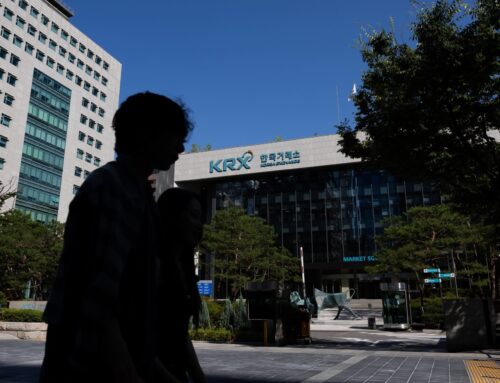Bonds are back in market crash, but the way investors are buying fixed-income has changed
April 7, 2025
Bonds are doing what they are supposed to do in a crashing market: offer investors a lower risk option as stocks tank and volatility rises tied to a new bout of global uncertainty, in this case President Trump’s tariffs.
The biggest bond exchange-traded funds, including the iShares Core US Aggregate Bond ETF (AGGBNDTLT
It’s a long-held wisdom that active managers can’t outperform their index over the long term. That’s a case made with stocks more so than bonds, and with prominent whipsaw examples like ARK Invest’s Cathie Wood, who came racing out of the starting gates years ago with actively managed equity ETFs that soared, only to come crashing back down to this statistical reality.
Last year was another bad one for active stock pickers in the fund industry, according to the SPIVA Scorecard published by S&P Global, with U.S. stock-pickers posting a 38% success rate versus index benchmarks, actually up 1% year over year.
But ETF experts say going active with bond ETFs may be a different story, and they have outperformed indexed bond funds with more consistency than active stock managers have been able to do historically. It is a case where it may make more sense to pay more, in the form of higher management fees on the ETFs, for the greater return potential.
That was the case last year. According to the SPIVA data, a majority of funds posted outperformance in 11 out of 16 fixed-income categories, and a 41% underperformance rate across all categories. That’s compared to 65% of U.S. large cap funds that underperformed the index. It wasn’t great across the board, but more accurately described by SPIVA as a year in bonds “with pockets of high outperformance.”
Going active at the core of fixed-income portfolio
What are called actively managed enhanced core bond funds — which seek to outperform the broad corporate bond index, “the AGG” — have taken the lion’s share of the new money from investors in the core bond asset class this year, five times as much as passively managed enhanced core bond index ETF counterparts, according to ETFaction.
Swift changes in treasury bond yields amid the Fed’s inflation fight were part of the reason that a more active hand in bonds worked well in 2024.
“Buying duration blindly has not had a smooth ride at all,” said Todd Sohn, who leads the ETF research team at Strategas, on last week’s “ETF Edge.”
Bond managers also point to the “uninvestable” nature of the core bond index that is the benchmark for AGG and BND, the Bloomberg U.S. Aggregate Bond Index.
“The AGG is flawed,” said Sohn. “If you’re a smart fixed income manager and you know your markets and you know the economics, you can get the exposures for that. I think that’s why you’re seeing this movement,” he added.
It’s a point that has been made repeatedly in recent weeks amid a flight to safety.
Jeffrey Katz, TCW managing director, recently told “ETF Edge” that the “60-40 portfolio” — 60% stocks and 40% bonds — “is doing its part” again, and it’s the active approach that has been paying off for investors as it allows them to deviate from an outdated AGG, with as much as $26 trillion in bond market opportunities that the AGG never touches. His firm’s TCW Flexible Income ETF (FLXR) has outperformed the AGG since its inception in 2018 by as much as 500 basis points.
“The indices are old and they don’t represent how we trade today,” said Alex Morris, chief investment officer at F/m Investments. “It’s been three decades,” he said alongside Katz on “ETF Edge.”
″Bond indices get bloated with tens of thousands of issuances,” Morris added.
According to Nate Geraci of the ETF Store, an investment advisory firm, there’s another reason many financial advisors are opting to go active with bond funds. Advisors, as a rule, are much more comfortable making active equity investment decisions on their own, he said on last week’s “ETF Edge,” and they are not as comfortable navigating the bond market. And Geraci said the data does show active fixed income managers have better track records than equity counterparts, so financial advisors are both more comfortable and seeing more value from the active approach to bonds.
Sohn and Geraci stressed that it’s not as if investors are abandoning stocks in the ETF context. Equity ETF flows have been on par with comparable time periods even amid the market tumult, and most long-term investors tend to keep their core exposure as it is regardless of short-term market volatility.
In general, investors aren’t looking to sell their core stock market holdings, but “investors are looking for ways to protect or shield the core,” Geraci said.
That goes for both fixed-income complements to stock funds, and also lower-risk equity plays getting more popular in the ETF universe.
Sohn said one of the most important takeaways from the action in actively managed ETFs is that “We’ve moved from the passive (index ETF) era to the complexity era.”
With over 200 ETF launches to date, and a big change on the horizon that could bring many more ideas from the active fund world into the ETF space, the ideas keep getting pumped out into the market. “Money goes where it’s treated best,” Sohn said.
Investors do need to remember that even as actively managed bond funds outperform in recent years, long-term outperformance remains a challenge for all managers in the market, equities and fixed income. According to SPIVA data, when it comes to actively managed bond funds that track the AGG, only 24% underperformed in the most recent one-year period, but that goes up to over 40% in the most recent five-year period, and 61% underperformers over a decade.
Over the past 15 years, “there were no categories in which a majority of active managers outperformed,” according to SPIVA — bonds included.
Sign up for our weekly newsletter that goes beyond the livestream, offering a closer look at the trends and figures shaping the ETF market.
Search
RECENT PRESS RELEASES
Related Post




